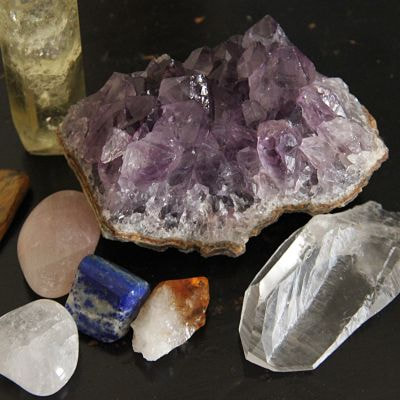Understand and clear your blocks to wellbeing.
There's many different forms of Kinesiology and each practitioner will approach it in their own unique way. While this is true for most health modalities, it seems particularly so for Kinesiology. If you've seen more than one Kinesiologist, you've likely experienced this first hand!
I practice holistic and energetic Kineisology. This means that my approach considers mind-emotion-body-spirit as interrelated and is based on an energy model of health. My Kinesiology sessions include discussion to help you gain insight and a deeper awareness of your situation and energy balancing, using for example acupressure, sound healing, flower essences, crystals and more.
To learn more about me and my overall approach to clinical practice, you can also take a look at the hello and how I can help you pages.
I practice holistic and energetic Kineisology. This means that my approach considers mind-emotion-body-spirit as interrelated and is based on an energy model of health. My Kinesiology sessions include discussion to help you gain insight and a deeper awareness of your situation and energy balancing, using for example acupressure, sound healing, flower essences, crystals and more.
To learn more about me and my overall approach to clinical practice, you can also take a look at the hello and how I can help you pages.
How Kinesiology can help.
People commonly visit me for Kinesiology for issues relating to (but not limited to):
- Stress management
- Emotional states (particularly overwhelm, anxiety, depression, self-esteem, fear, frustration, grief)
- Life purpose/life path
- Decision making
- Seeking a deeper connection to intuition or spirituality
- Transitioning through major life changes (e.g. relationship, career)
- Feeling stuck in negative behaviour patterns
- Work-life balance
- Physical issues with an emotional or stress-related aspect
- Feeling ‘out of sorts’, ‘blah’ or physically unwell for no apparent reason
- 'Check in' sessions - where there is nothing particularly 'wrong' but they would like to check in with themselves and have an energetic 'tune-up.' These can be regular (e.g. every 4-6 weeks) or as required
What is Kinesiology?
|
Kinesiology literally means the ‘study of movement’. Kinesiology uses muscle response as a feedback tool combined with Chinese Medicine/Acupuncture wisdom.
Kinesiology initially began as Academic Kinesiology in the 1940s, where muscle 'tests' were developed to assess muscle function and strength (Kendall and Kendall). In the 1960's, muscle testing was incorporated into Chiropractic practice and combined with Chinese Medicine concepts. Applied Kinesiology was born (Goodheart). In the 1970's/80's, Applied Kinesiology was expanded by other Chiropractors to Touch for Health (Thie) and Clinical Kinesiology (Beardall). Clinical Kinesiology formed the foundation for holistic and energetic Kinesiology. Since then, a diverse and ever-growing range of holistic and energetic Kinesiology modalities have developed. This really (really!) brief history helps to explain the vast diversity in how Kinesiologists practice. |
My approach to Kinesiology.
In our sessions I use muscle monitoring, essentially just gently pushing down on your arm, as a way to 'hear' what your body is saying. Muscle monitoring assesses energy ('Qi') flow in the body - if the muscle moves there is an 'under energy', if it can be held there is balanced Qi flow.
Questions and statements impact Qi flow and therefore change how the muscle responds. Muscle monitoring bypasses the conscious mind and can bring to light the (often unknown) underlying factors contributing to your concern.
I also practice Kinesiology very intuitively to 'hear' what other factors may be important and intelligently to ensure what comes up is relevant and useful.
During a session, we discuss at depth the information from muscle monitoring and intuitive guidance. I help you understand the causes of your concern, related factors and help you see the bigger picture of how it impacts your life right here, right now. I facilitate the process of you making connections yourself and together we discover what practical tools will support you to move forward.
I also practice Kinesiology very intuitively to 'hear' what other factors may be important and intelligently to ensure what comes up is relevant and useful.
During a session, we discuss at depth the information from muscle monitoring and intuitive guidance. I help you understand the causes of your concern, related factors and help you see the bigger picture of how it impacts your life right here, right now. I facilitate the process of you making connections yourself and together we discover what practical tools will support you to move forward.
This approach allows me to help you:
- Identify imbalances in your life
- Understand the causes of imbalance and related factors
- Determine what you, as an individual, need to restore balance and wellbeing
"When you listen generously to people,
they can hear the truth in themselves, often for the first time”
- RACHEL NAOMI REMEN
What happens in a kinesiology session?
Initial: 60-70 mins (includes a brief health history questionnaire)
Follow-up session: 60 mins
Your session involves:
Energy balancing approaches may include:
Follow-up session: 60 mins
Your session involves:
- Detailed discussion of your reason for visiting
- Lying face up on a massage table
- Remaining fully clothed with shoes removed
- Muscle monitoring and lots of discussion to identify where imbalances exist for you and why
- Energy balancing to restore Qi flow, balance and wellbeing
Energy balancing approaches may include:
- Acupressure (points are held, needles aren’t used)
- Flower essences
- Sound healing
- Essential oils
- Crystals
- Affirmations
- Visualisations
- Chakra healing
- Colour and light therapy
After the session.
You may need to do some activities at home to support the session. This may involve, for example, repeating an affirmation, taking a flower essence or spending time in nature.
Afterwards, drink plenty of water and try to avoid anything physically strenuous or emotionally challenging. I recommend a calm state and environment so you can integrate the session. You may wish to go on a gentle walk, spend some time in quiet reflection or journal your thoughts.
People have different responses to kinesiology. Most people feel say they feel lighter, clearer and happier. However it’s not uncommon to feel tired, ‘flat’ or have negative emotions surface. Rest assured this is a normal part of the healing process and can occur when a big shift has taken place. In most cases the ikky stuff resolves within a day or two. If you’re at all concerned, please get in touch.
Afterwards, drink plenty of water and try to avoid anything physically strenuous or emotionally challenging. I recommend a calm state and environment so you can integrate the session. You may wish to go on a gentle walk, spend some time in quiet reflection or journal your thoughts.
People have different responses to kinesiology. Most people feel say they feel lighter, clearer and happier. However it’s not uncommon to feel tired, ‘flat’ or have negative emotions surface. Rest assured this is a normal part of the healing process and can occur when a big shift has taken place. In most cases the ikky stuff resolves within a day or two. If you’re at all concerned, please get in touch.
How many sessions are needed?
The number of sessions required varies person to person and the reason for the visit. If it's your first kinesiology session or you have a lot going on, a follow up in around 2 weeks will help ensure you stay on track.
If your concern is chronic or high intensity, I encourage you to consider regular sessions around 4-6 weeks apart. You may also wish to have regular sessions to support your journey and growth. The choice is yours! You'll often intuitively know when you need another session (even if nothing is 'wrong') and when to stop a series of sessions.
If your concern is chronic or high intensity, I encourage you to consider regular sessions around 4-6 weeks apart. You may also wish to have regular sessions to support your journey and growth. The choice is yours! You'll often intuitively know when you need another session (even if nothing is 'wrong') and when to stop a series of sessions.
Kinesiology precautions.
Kinesiology is gentle and non-invasive and is appropriate to have with the majority of health conditions.
I provide Kinesiology support to women throughout their pregnancy. In late pregnancy, it's often more comfortable to do the session laying on your side with plenty of pillow support. A number of Acupuncture points and certain essential oils are contraindicated in pregnancy, so these are avoided.
Flower essences contain alcohol (brandy) and are often taken orally. This may not be appropriate for everyone due to religious, sobriety or other reasons. Flower essences can be taken during pregnancy although some mums-to-be prefer to avoid them.
I provide Kinesiology support to women throughout their pregnancy. In late pregnancy, it's often more comfortable to do the session laying on your side with plenty of pillow support. A number of Acupuncture points and certain essential oils are contraindicated in pregnancy, so these are avoided.
Flower essences contain alcohol (brandy) and are often taken orally. This may not be appropriate for everyone due to religious, sobriety or other reasons. Flower essences can be taken during pregnancy although some mums-to-be prefer to avoid them.

